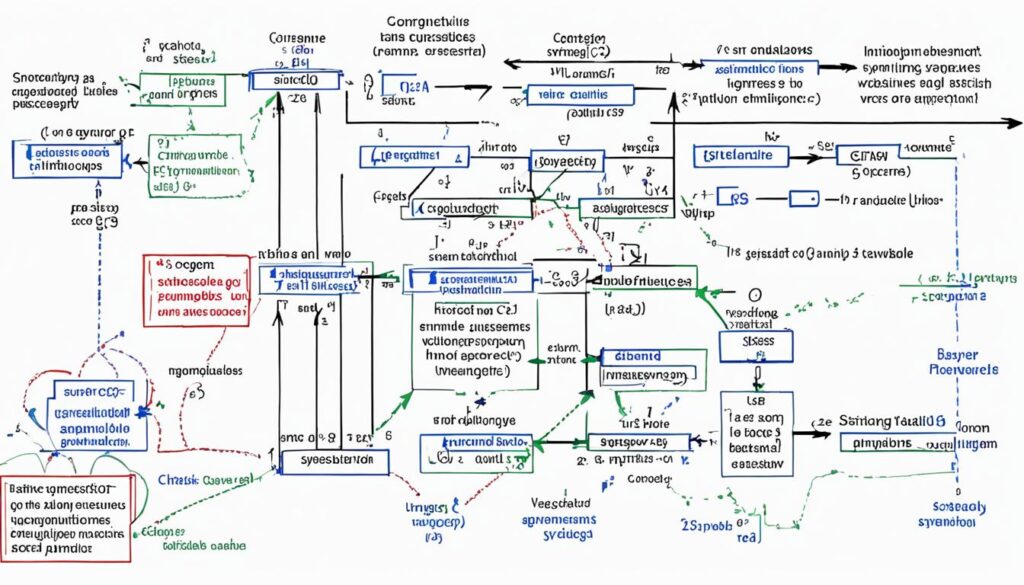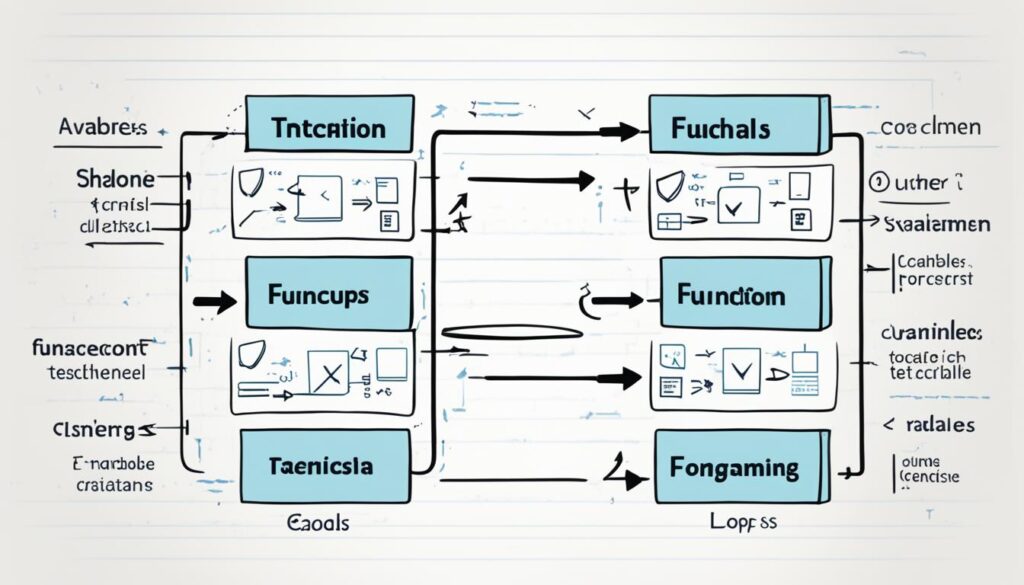Welcome to our article on the fundamental concepts of task and function in System Verilog! As hardware designers, we know how crucial it is to streamline our coding process and improve the efficiency of our designs. That’s where tasks and functions in System Verilog come into play. They are powerful constructs that enable us to enhance code organization, reusability, and modularity.
In this article, we’ll delve into the syntax, characteristics, and practical applications of tasks and functions in System Verilog. We’ll explore how these constructs can simplify our coding efforts and optimize the verification process. So, let’s dive in and unlock the full potential of tasks and functions in System Verilog!
Table of Contents
Understanding Tasks
Tasks play a crucial role in System Verilog, allowing us to execute a series of statements in a sequential manner. A task is a procedural block that encompasses a set of actions, making it easier to organize and reuse code. Let’s dive deeper into the syntax, characteristics, and practical applications of tasks in System Verilog.
Syntax of Tasks
A task in System Verilog is defined using the task keyword, followed by an optional return type, a task name, and a parameter list enclosed in parentheses. Here’s an example:
<task_return_type> task <task_name>(parameter_list);
// Task statements go here
endtask
The parameter_list specifies the inputs required for the task, which can be passed by value or by reference. These parameters provide flexibility and allow the task to work with different data values.
Characteristics of Tasks
Tasks have a few distinctive characteristics that differentiate them from other constructs:
- Tasks can contain both sequential and parallel blocks of code, enabling the execution of multiple actions simultaneously.
- They can have local variables that are visible only within the task scope, making it easier to encapsulate data and avoid conflicts.
- Tasks can be called from other tasks, functions, or within modules, promoting code modularity and reusability.
Practical Applications of Tasks
Tasks are widely used in System Verilog for various purposes, including:
- Grouping related operations together, improving code organization and readability.
- Creating reusable code snippets that can be called multiple times, saving development time and effort.
- Implementing complex behavior within a module by dividing it into smaller tasks.
By utilizing tasks effectively, you can enhance code clarity, simplify debugging, and facilitate code maintenance in your System Verilog projects.
Utilizing Functions
Functions play a vital role in System Verilog, similar to tasks. They are procedural blocks designed to perform specific computations and return a value. By encapsulating code within these functions, you can ensure modularity and maintainability in your System Verilog codebase.
System Verilog provides various types of functions, each with its own advantages and use cases. Let’s explore some of these functions:
1. Inline Functions
An inline function is a small function that is directly inserted into the calling code during compilation. This eliminates the overhead of function calls and enhances efficiency. Inline functions are perfect when you need a small, reusable piece of code that can be easily optimized.
2. Pure Functions
Pure functions are functions that do not have any side effects and produce the same output for the same input. These functions are especially useful in functional and parallel programming paradigms, as they ensure determinism and allow for easier verification and debugging.
3. System Functions
System functions are predefined functions provided by the System Verilog language. These functions offer a wide range of functionalities, such as type conversion, random number generation, and string manipulation. Leveraging these functions can significantly simplify your code and enhance its readability.
4. User-Defined Functions
User-defined functions are custom functions created by the developer according to specific requirements. These functions provide flexibility and allow you to implement complex logic and algorithms within your System Verilog designs. They are particularly useful when you want to encapsulate a set of operations into a single function.
Now, let’s take a closer look at some practical use cases for functions in System Verilog:
- Verifying complex arithmetic operations
- Performing data transformations and conversions
- Implementing mathematical models and algorithms
- Handling complex conditional statements
By utilizing functions effectively, you can enhance code organization, readability, and reuse. Let’s proceed to the next section to delve into the details of passing arguments to functions in System Verilog.
Passing Arguments
In System Verilog, passing arguments to tasks and functions plays a crucial role in designing efficient and modular code. Understanding the different argument passing methods and their implications allows us to develop code that is both maintainable and easily debuggable.
Positional Arguments
One way to pass arguments is through positional arguments, where the values are assigned based on the order they are listed in the task or function call. For example:
“`systemverilog
// Defining a task with positional arguments
task myTask(input logic a, input logic b, output logic c);
// Task implementation here
endtask
…
// Calling the task with positional arguments
myTask(1’b1, 1’b0, c);
“`
In the example above, we pass the values 1’b1 and 1’b0 as the first two arguments, corresponding to inputs ‘a’ and ‘b’, respectively. The value of ‘c’ is assigned as an output of the task.
Named Arguments
Another method of passing arguments is through named arguments, where the values are assigned based on the argument names specified in the task or function call. This method provides more flexibility, as it allows us to specify values for specific arguments, regardless of their order. For example:
“`systemverilog
// Defining a function with named arguments
function logic myFunction(input logic x, input logic y);
// Function implementation here
endfunction
…
// Calling the function with named arguments
myFunction(.x(1’b1), .y(1’b0));
“`
In the example above, we pass the values 1’b1 and 1’b0 to the arguments ‘x’ and ‘y’ respectively, using the dot notation.
Default Arguments
In System Verilog, we can also assign default values to arguments in tasks and functions. This allows us to omit arguments in the task or function call, and the default value will be used instead. Default arguments can be helpful when certain parameters have common or typical values. For example:
“`systemverilog
// Defining a function with a default argument
function logic myFunction(input logic x = 1’b0);
// Function implementation here
endfunction
…
// Calling the function without specifying the argument
myFunction();
“`
In the example above, if we call the function without specifying the value for ‘x’, the default value of 1’b0 will be assigned to it.
Pass by Value vs Pass by Reference
When passing arguments to tasks and functions, it is important to understand the difference between pass by value and pass by reference. By default, arguments are passed by value, meaning that a copy of the argument’s value is made and used within the task or function. This ensures that the original value remains unchanged. However, if we want to modify the original value of an argument within a task or function, we can use the pass by reference method. By passing the argument using the ‘ref’ keyword, any changes made to the argument within the task or function will also affect the original value. Here is an example:
“`systemverilog
// Defining a task with a pass by reference argument
task modifyValue(ref logic a);
a = 1’b1; // Modifying the value within the task
endtask
…
// Calling the task with a pass by reference argument
logic val = 1’b0;
modifyValue(ref val);
“`
In the example above, we pass the argument ‘val’ to the task ‘modifyValue’ using the ‘ref’ keyword. Any changes made to ‘a’ within the task will also modify the value of ‘val’ outside the task.
Summary
Understanding how to pass arguments to tasks and functions in System Verilog allows us to write structured and efficient code. Whether using positional or named arguments, or assigning default values, selecting the appropriate argument passing method is essential for successful code development and debugging.

Task and Function Lifecycle
In System Verilog, tasks and functions have their own lifecycle, which encompasses the steps of compilation, execution, and termination. Understanding this lifecycle is essential for gaining a comprehensive understanding of how these constructs work behind the scenes. Let’s explore each step in detail.
1. Compilation
During the compilation phase, the System Verilog compiler analyzes the code containing tasks and functions. It checks the syntax, resolves any references to variables or modules, and generates an intermediate representation of the code for execution.
2. Initialization
After the compilation, the tasks and functions are initialized. In this step, the storage for local variables and function/task arguments is allocated, and any initializations specified within the code are performed. This ensures that the constructs are ready for execution.
3. Execution
Once the initialization is complete, the tasks and functions are ready to be executed. During execution, the statements within the constructs are processed sequentially, carrying out the intended computations or operations. Tasks may perform actions such as driving signals, reading inputs, or initiating simulations, while functions focus on computations and returning values.
4. Cleanup and Termination
After the execution is finished, the tasks and functions proceed to the cleanup and termination phase. In this step, any resources allocated during initialization, such as memory or file handles, are released. The constructs return control to the calling code, and any return values from functions are passed back accordingly.
Understanding the lifecycle of tasks and functions in System Verilog provides valuable insights into their behavior and enables efficient code development. By diving into each step of the lifecycle, you can optimize your hardware designs and make informed decisions throughout the coding process.
Advanced Techniques and Best Practices
When it comes to System Verilog, mastering advanced techniques and implementing best practices can significantly elevate your hardware modeling and verification process. In this section, we’ll explore some essential strategies and methodologies that will optimize your code and enhance efficiency.
Parameterized Functions
One of the key advanced techniques in System Verilog is the use of parameterized functions. By utilizing function parameters, you can create flexible and reusable code that adapts to different scenarios. This allows for the creation of generic functions that cater to varying input requirements, enhancing the versatility and scalability of your codebase.
Hierarchical Design Methodologies
Implementing hierarchical design methodologies is another best practice within System Verilog. By breaking down complex designs into smaller, manageable modules, you can improve code readability, maintainability, and reusability. Hierarchical design also promotes efficient team collaboration, making it easier to work on different aspects of the project concurrently.
When utilizing hierarchical design, it’s crucial to establish clear and consistent naming conventions, module interfaces, and communication protocols between different modules. This ensures smooth integration and reduces the chances of errors and conflicts during the development process.
Data Encapsulation and Abstraction
Data encapsulation and abstraction are fundamental concepts in System Verilog that enhance code organization and improve readability. Encapsulating data within modules and providing well-defined interfaces helps in reducing the complexity of the codebase, making it easier to understand and maintain.
Abstraction allows you to hide intricate details of complex modules behind simpler interfaces, providing a higher-level view of the functionality. This helps in simplifying code comprehension and allows for easier debugging and troubleshooting.
Error Handling and Debugging
Implementing robust error handling mechanisms and efficient debugging techniques is a crucial best practice in System Verilog. By incorporating comprehensive error handling logic, you can catch and handle potential issues and exceptions, improving the reliability and stability of your code.
Furthermore, implementing effective debugging techniques, such as using assertions and intelligent waveform analysis tools, helps in identifying and resolving issues quickly. This saves valuable development time and ensures that your hardware designs are thoroughly tested and verified.
By incorporating these advanced techniques and best practices into your System Verilog projects, you can optimize your codebase, enhance productivity, and improve the quality and reliability of your hardware designs. Let’s explore these concepts further in the table below:
| Advanced Techniques | Best Practices |
|---|---|
| Parameterized Functions | Data Encapsulation and Abstraction |
| Hierarchical Design Methodologies | Error Handling and Debugging |

Conclusion
In conclusion, tasks and functions play a crucial role in System Verilog, providing an efficient way to streamline code development for hardware modeling and verification. By mastering their syntax, understanding their characteristics, and following best practices, you can enhance your coding skills and improve the overall efficiency of your hardware designs.
Tasks, as procedural blocks, allow you to execute a series of statements sequentially, enabling code organization and reusability. Functions, on the other hand, perform specific computations and return values, promoting modular coding and facilitating code maintenance.
With a comprehensive understanding of tasks and functions, you can effectively leverage their power to optimize your hardware modeling and verification process. By employing advanced techniques and following industry best practices, such as parameterized functions and hierarchical design methodologies, you can take your coding skills to the next level and achieve higher efficiency in your projects.

